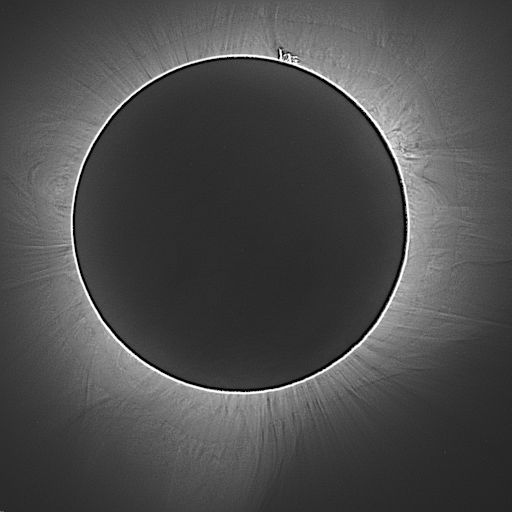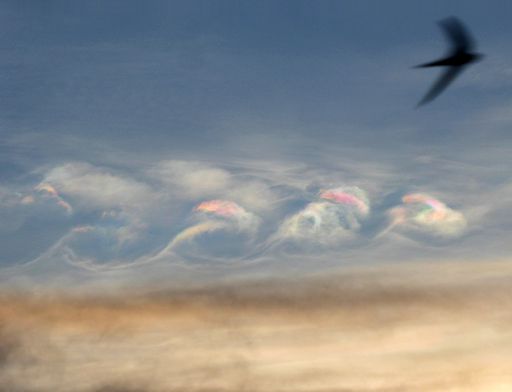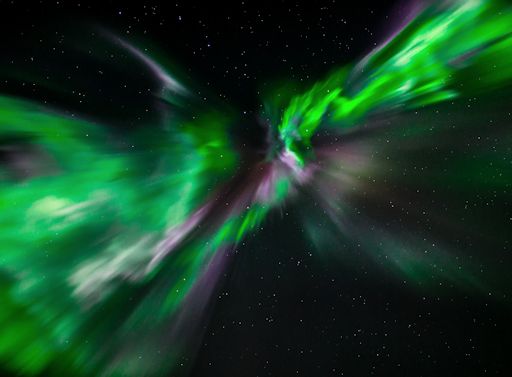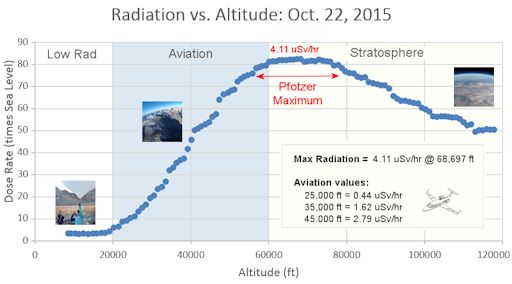Marianne's Heaven On Earth Aurora Chaser Tours Chasethelighttours.co.uk invites you to join them in their quest to find and photograph the Aurora Borealis. Experience the winter wonderland in the Tromsø Area. | | |
GEOMAGNETIC STORM: A G1-class geomagnetic storm is brewing on March 14th as Earth enters a zone of negative-polarity solar wind. Magnetic fields in this region point south, a condition which can open a crack in Earth's magnetosphere. Arctic sky watchers should be alert for auroras as solar wind pours through the opening. Aurora alerts: text or voice
HAPPY PI DAY: Today, March 14th (3.14), is  day, and all around the world pi-philes are celebrating one of the most compelling and mysterious constants of Nature. Pi appears in equations describing the orbits of planets, the colors of auroras, the structure of DNA. The value of
day, and all around the world pi-philes are celebrating one of the most compelling and mysterious constants of Nature. Pi appears in equations describing the orbits of planets, the colors of auroras, the structure of DNA. The value of  is woven into the fabric of life, the universe and ... everything.
is woven into the fabric of life, the universe and ... everything.
Humans have struggled to calculate  for thousands of years. Divide the circumference of a circle by its diameter; the ratio is
for thousands of years. Divide the circumference of a circle by its diameter; the ratio is  . Sounds simple, but the devil is in the digits. While the value of
. Sounds simple, but the devil is in the digits. While the value of  is finite (a smidgen more than 3), the decimal number is infinitely long:
is finite (a smidgen more than 3), the decimal number is infinitely long:
3.1415926535897932384626433832795
02884197169399375105820974944592307
81640628620899862803482534211706...more
Supercomputers have succeeded in calculating more than 2700 billion digits and they're still crunching. The weirdest way to compute  : throw toothpicks at a table or frozen hot dogs on the floor. Party time.
: throw toothpicks at a table or frozen hot dogs on the floor. Party time.
THE GHOSTLY CORONA, REVEALED: One of the great attractions of a total eclipse is the chance to see something usually invisible to the human eye: the sun's ghostly corona. Normally overwhelmed by the glare of the solar disk, the gossamer outer atmosphere of our star reveals itself only when the Moon intervenes. On March 9th in Indonesia, it revealed itself in richly-textured detail:

This remarkable picture was taken by a team of undergraduate researchers observing the total eclipse from Tanjung Pandan (Belitung Island). Matt Penn of the National Solar Observatory in Tucson, Arizona, explains:
"In preparation for the 2017 'Great American Eclipse,' and to train some undergraduates who will be in the path of that event, we sent 5 teams to Indonesia with help from NASA funding with the equipment we hope to use next year in the USA. The goal was to take white light coronal images at high cadence. This first-look image from one of the sites shows that we succeeded."
Studying the corona is important because it is a primary source of space weather. The solar wind emerges from the corona, as do coronal mass ejections (CMEs), which can spark strong geomagnetic storms when they hit Earth.
Spacecraft such as STEREO and SOHO are equipped with coronagraphs that block the sun's glare; but no man-made coronagraph is as good as the Moon. "The field of view of space coronagraphs does not include the lower regions of the corona, becase blocking the sun is difficult in the presence of spacecraft jitter," says Penn. "That's why we love solar eclipses."
"One of our science targets is the dynamics of the polar plumes above the north and south coronal holes," Penn continues. "There is evidence that in these denser regions there are periodic or quasi-periodic enhancements which propagate outward from the sun."
"The undergraduate students involved in this project are Sarah Kovac, Logan Jensen, Honor Hare and Myles McKay," says Penn."Their mentors are Bob Baer, Michael Pierce, Richard Gelderman and Don Walter. None of this team had ever seen a solar eclipse before, and none of the students had ever traveled outside the USA. Now they are returning with world-class observations of the solar corona. Congratulations!"
March 9th Solar Eclipse Photo Gallery
VAN GOGH CLOUDS: Peter Lowenstein lives in Mutare, Zimbabwe. For a few minutes last Friday, he felt as if he were transported from Africa into a painting by Vincent van Gogh. "Just before sunset," says Lowenstein, "a thin band of wavy clouds developed above a cumulonimbus anvil and became iridescent." He snapped this picture:

These clouds, sometimes called "billow clouds," are produced by the Kelvin-Helmholtz instability when horizontal layers of air brush by one another at different velocities. It is widely believed that these waves in the sky inspired the swirls in van Gogh's masterpiece The Starry Night.
The delicate pastel colors of the waves come from irridescence--the diffraction of sunlight by tiny water droplets in the clouds. As the sun set, the colors faded to gray, returning Lowenstein to his porch in Zimbabwe.
More photos that can transport you to strange and beautiful places may be found in the realtime gallery:
Realtime Spaceweather Photo Gallery
AURORAS OVERHEAD: On Friday, March 11th, an unexpected CME sideswiped Earth's magnetic field, sparking a G2-class geomagnetic storm. At the peak of the storm, Martin Guth of Fairbanks, Alaska, looked up and saw this:

"This was the most impressive auroral event I have ever witnessed," says Guth, "and although it was short, it made up for it via intensity!"
This is a good time of year for auroras. For reasons that are only partially understood, geomagnetic storms favor the weeks around equinoxes; even a gentle gust of solar wind can spark a good display. More lights are possible this weekend as Earth moves deeper into the wake of the CME. NOAA forecasters estimate a 25% chance of additional geomagnetic storms on March 13th. Aurora alerts: text or voice
Realtime Aurora Photo Gallery
Realtime Spaceweather Photo Gallery
Realtime Comet Photo Gallery
Every night, a network of
NASA all-sky cameras scans the skies above the United States for meteoritic fireballs. Automated software maintained by NASA's Meteoroid Environment Office calculates their orbits, velocity, penetration depth in Earth's atmosphere and many other characteristics. Daily results are presented here on Spaceweather.com.
On Mar. 14, 2016, the network reported 10 fireballs.
(10 sporadics)

In this diagram of the inner solar system, all of the fireball orbits intersect at a single point--Earth. The orbits are color-coded by velocity, from slow (red) to fast (blue). [Larger image] [movies]
Potentially Hazardous Asteroids (
PHAs) are space rocks larger than approximately 100m that can come closer to Earth than 0.05 AU. None of the known PHAs is on a collision course with our planet, although astronomers are finding
new ones all the time.
On March 14, 2016 there were potentially hazardous asteroids.
 |
Notes: LD means "Lunar Distance." 1 LD = 384,401 km, the distance between Earth and the Moon. 1 LD also equals 0.00256 AU. MAG is the visual magnitude of the asteroid on the date of closest approach. | | Cosmic Rays in the Atmosphere |
| Situation Report -- Oct. 30, 2015 | Stratospheric Radiation (+37o N) |
| Cosmic ray levels are elevated (+6.1% above the Space Age median). The trend is flat. Cosmic ray levels have increased +0% in the past month. |
| Sept. 06: 4.14 uSv/hr (414 uRad/hr) |
| Sept. 12: 4.09 uSv/hr (409 uRad/hr) |
| Sept. 23: 4.12 uSv/hr (412 uRad/hr) |
| Sept. 25: 4.16 uSv/hr (416 uRad/hr) |
| Sept. 27: 4.13 uSv/hr (413 uRad/hr) |
| Oct. 11: 4.02 uSv/hr (402 uRad/hr) |
| Oct. 22: 4.11 uSv/hr (411 uRad/hr) |
These measurements are based on regular space weather balloon flights: learn more. Approximately once a week, Spaceweather.com and the students of Earth to Sky Calculus fly "space weather balloons" to the stratosphere over California. These balloons are equipped with radiation sensors that detect cosmic rays, a surprisingly "down to Earth" form of space weather. Cosmic rays can seed clouds, trigger lightning, and penetrate commercial airplanes. Our measurements show that someone flying back and forth across the continental USA, just once, can absorb as much ionizing radiation as 2 to 5 dental X-rays. For example, here is the data from a flight on Oct. 22, 2015:

Radiation levels peak at the entrance to the stratosphere in a broad region called the "Pfotzer Maximum." This peak is named after physicist George Pfotzer who discovered it using balloons and Geiger tubes in the 1930s. Radiation levels there are more than 80x sea level.
Note that the bottom of the Pfotzer Maximim is near 55,000 ft. This means that some high-flying aircraft are not far from the zone of maximum radiation. Indeed, according to the Oct 22th measurements, a plane flying at 45,000 feet is exposed to 2.79 uSv/hr. At that rate, a passenger would absorb about one dental X-ray's worth of radiation in about 5 hours.
The radiation sensors onboard our helium balloons detect X-rays and gamma-rays in the energy range 10 keV to 20 MeV. These energies span the range of medical X-ray machines and airport security scanners.
| | The official U.S. government space weather bureau |
| | The first place to look for information about sundogs, pillars, rainbows and related phenomena. |
| | Researchers call it a "Hubble for the sun." SDO is the most advanced solar observatory ever. |
| | 3D views of the sun from NASA's Solar and Terrestrial Relations Observatory |
| | Realtime and archival images of the Sun from SOHO. |
| | from the NOAA Space Environment Center |
| | the underlying science of space weather |

